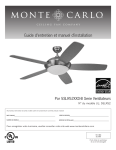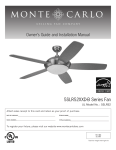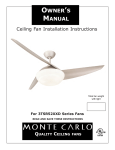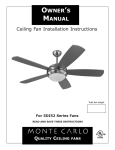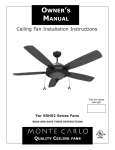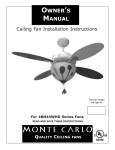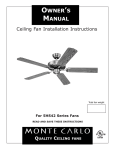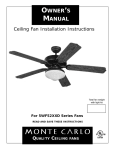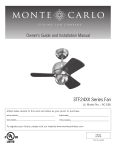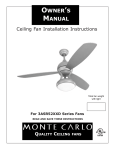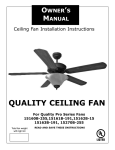Download Monte Carlo Fan Company 5SLR52 Owner`s manual
Transcript
OWNER’S MANUAL Ceiling Fan Installation Instructions Total fan weight with light For 5SLR52 Series Fans READ AND SAVE THESE INSTRUCTIONS QUALITY CEILING FANS Installation SAFETY TIPS WARNING: TO REDUCE THE RISK OF FIRE, ELECTRIC SHOCK, OR INJURY TO PERSONS, OBSERVE THE FOLLOWING: READ AND SAVE THESE INSTRUCTIONS 1. 2. 3. 4. 5. 6. 7. 8. 9. 10. 11. 12. 13. 14. 15. Installation work and electrical wiring must be done by qualified person(s) in accordance with applicable codes ANSI/NFPA 70-1999), including fire-rated construction. Use this unit only in the manner intended by the manufacturer. If you have any questions contact the manufacturer. After making the wire connections, the wires should be spread apart with the grounded conductor and the equipment-grounding conductor on one side of the outlet box and ungrounded conductor on the other side of the outlet box. Before you begin installing the fan, Switch power off at Service panel and lock service disconnecting means to prevent power from being switched on accidentally. When the service disconnecting means cannot be locked, securely fasten a prominent warning device, such as a tag, to the service panel. Be cautious! read all instructions and safety information before installing your new fan. Review the accompanying assembly diagrams. When cutting or drilling into wall or ceiling, do not damage electrical wiring and other hidden utilities. Make sure the installation site you choose allows the fan blades to rotate without any obstructions. Allow a minimum clearance of 7 feet from the floor to the trailing edge of the blade. To reduce the risk of fire, electric shock, or personal injury, mount to outlet box or supporting system acceptable for fan support. Use only the screws provided with the outlet box. (Mounting must support at least 35 lbs.) Do not bend blade holders during installation to motor, balancing or during cleaning. Do not insert foreign object between rotating blades. Attach the mounting bracket using only the hardware supplied with the outlet box. WARNING - To reduce the risk of fire or electric shock, this fan should be used with fan speed control part no. UC7067RC-L, manufactured by Rhine Electronic Co., Ltd. The combustion airflow needed for safe operation of fuel-burning equipment may be affected by this unit’s operation. Follow the heating equipment manufacturer’s guideline safety standards such as those published by the National Fire Protection Association (NFPA), and the American Society for Heating, Refrigeration and Air Conditioning Engineers (ASHRAE) and the local code authorities. Before servicing or cleaning unit, Switch power off at Service panel and lock service disconnecting means to prevent power from being switched on accidentally. When the service disconnecting means cannot be locked, securely fasten a prominent warning device, such as a tag, to the service panel. WARNING - To reduce the risk of electric shock, this fan must be installed with an isolating wall contorl,switch. WARNING - All set screws must be checked and retightened where necessary before installation. 1 Phillips Screwdriver Before you begin installing the fan, Switch power off at Service panel and lock service disconnecting means to prevent power from being switched on accidentally. When the service disconnecting means cannot be locked, securely fasten a prominent warning device, such as a tag, to the service panel. 2 TOOLS REQUIRED Wire Cutters Pliers Before installing this fan make sure the outlet box is properly installed to the house structure. To reduce the risk of fire, electric shock, or personal injury, mount to outlet box or supporting system acceptable for fan support. (Mounting must support at least 35 lbs.) 3 Step Ladder Use metal outlet box suitable for fan support (must support 35 lbs). Before attaching fan to outlet box, ensure the outlet box is securley fastened by at least two points to a structural ceiling member ( a loose box will cause the fan to wabble). Use only the screws provided with the outlet box. 4 5 6 Loosen the 2 set screws till you can not feel them on inside of yoke. Remove keeper from pin and pin from downrod. Place keeper back on pin and save for later. Thead leadwires and safety cable through downrod. (as shown) 7 8 9 Place yoke cover on downrod. (as shown) Thread leadwires and safety cable through downrod. (as shown) Place downrod into fan yoke. 10 11 12 Align the hole in the downrod with the hole in the yoke. Insert th pin through the yoke and downrod until the point appears on the other side. Install the keeper to pin. Tighten the 2 set screws on the yoke once the downrod is in place. 13 14 15 Safety cable installation Safety Cable Lag Screw safety cable washer Pull down yoke cover. 16 Hang assembled fan from the mounting bracket installed to ceiling in previous step. Make sure the fan is hanging straight. Rotate fan until the tab on the Mounting bracket engages the slot on the Downrod Ball. This must be done to prevent the fan body from rotating when the blades are in motion. 17 Remote Transmitter Dip switches 3” lag screw lock washer Fan and light kit combinations over 35 lbs, in both flush and downrod mode the safety cable must be installed into the house structure beams using the 3” lag screws,washers, and lock washers. provided. Make sure that when the safety cable is fully extended the lead wires are longer than the cable and no stress is placed on the lead wires. 18 Remote Receiver Dip switches Make sure the studs protruding from the bottom of the Mounting bracket are installed with threads all the way through the bracket. Set dip switches on the Remote Transmitter and Remote Receiver to the same settings. This must be done so the units will communicate properly. If you have other fans you can set to control from one transmitter by setting both receivers the same as the transmitter. If you have more than one fan with remote. You can set the dip switches to different positions to have seperate control. Install remote receiver into mounting bracket. 19 Ready for wiring 22 Make wire connections to power source using wire nuts provided. Make sure that no filiments are outside of the wirenut. After making the wire connections, the wires should be spread apart with the grounded conductor and the equipment-grounding conductor on one side of the outlet box and ungrounded conductor on the other side of the outlet box. 20 Connect black from remote receiver to black or (hot) wire from house. Connect white wire from remote receiver to white (neutral) wire from house. Connect green ground leads from mounting bracket and downrod to ground lead from house. Refer to Safety Tips section of manual. 23 21 Make wiring connections for remote receiver to fan as above diagram. 24 Lift canopy and install knurled nuts as shown. Tighten the knurled nuts securely. The canopy should adjust for any irregularity in the ceiling or Outlet box. Attach blades to motor using screws and washers in hardware bag and tighten screws securely. 26 27 Connect plug from fan to switch house plug. (as shown) Install light plate with ballast to fan by twisting plate with key hole slots into place. Replace screw removed and tighten the 3 screws securely. 28 29 30 Plug ballast into the flourescent lamp. Carefully snap flurescent lamp into clips. Attach glass by locating dimples in light kit with the groves in glass and twist clockwise till tight. 25 Loosen 2 screws and remove 1 screw from motor plate. Save removed screw for use later. 31 Remove cover by snapping off from top or bottom. Install 12V battery into wall remote. Duracell MN21 / Eveready A23 / GP 23A. 32 33 Attach cover of remote by placing over buttons and snapping into place. Install wall control unit to outlet box using machine screws provided. 34 35 Fan speed control buttons Light dimmer for lights Fan reverse button Fan on / off Attach front cover to wall control with screws provided. To control fan speed select from High, Medium or Low speed buttons. To turn the fan off press the fan on / off button. To dim lights press and hold button. To turn off light press and quickly release button. Press button marked REV to reverse the rotation direction of the fan blades with fan on low or med. TROUBLE SHOOTING If you have difficulty operating your new ceiling fan, it may be the result of incorrect assembly, installation, or wiring. In some cases, these installation errors may be mistaken for defects. If you experience any faults, please check this Trouble Shooting Chart. If a problem cannot be remedied, or you are experiencing difficulty in installation, please call our Customer Service Center at the number printed on your parts list insert sheet. Warning: Before servicing or cleaning unit, Switch power off at Service panel and lock service disconnecting means to prevent power from being switched on accidentally. When the service disconnecting means cannot be locked, securely fasten a prominent warning device, such as a tag, to the service panel. 1. If fan does not start: 2. If fan sounds noisy: 3. If fan wobbles: 4. If light does not work: 1.Check main and branch circuit fuses or circuit breakers. 2.Check line wire connections to fan and switch wire connections in switch housing. CAUTION: Make sure main power is turned off. 3.Make sure forward/reverse switch is firmly in up or down position. Fan will not operate when switch is in the middle. 1.Check to make sure all screws in motor housing are snug (not over tightened). 2.Check to make sure the screws which attach the fan blade holder to the motor are tight. 3.Check to make sure wire nut connectors in switch housing are not rattling against each other or against the interior wall of the switch housing. CAUTION: Make sure main power is turned off before entering switch housing. 4.If using an optional Ceiling Fan Light Kit, check to be sure the screws securing the glassware are finger tight. Check to be sure light bulb is tight in socket and not touching glass shade(s). If vibration persists from glass, remove glass and install a 1/4" wide rubber band on glass neck to act as an insulator. Replace glass and tighten screws against rubber band. 5.Some fan motors are sensitive to signals from Solid State variable speed controls. DO NOT USE a Solid State variable speed control. 6.Allow "break-in" period of 24 hours. Most noises associated with a new fan will disappear after this period. 1.Make sure that the ridge of the canopy engages the notch in the downrod ball. (See illustration in Step #6 of Downrod Mount installation). 2.Check that all blades are screwed firmly into blade holders. 3.Check that all blade holders are tightened securely to motor. 4.Make sure that canopy and mounting bracket are tightened securely to ceiling junction box and junction box is mounted firmly to ceiling joist. 5.Most fan wobble problems are caused when blade levels are unequal. Check this level by selecting a point on the ceiling above the tip of one of the blades. Measure this distance from blade tip to ceilng. Keeping measure within 1/8", rotate the fan until the next blade is positioned for measurement. Repeat for each blade. If all blade levels are not equal, you can adjust blade levels by the following procedure. To adjust a blade tip down, insert a washer (not supplied) between the blade and blade holder at the screw closest to the motor. To adjust a blade tip up, insert washer (not supplied) between the blade and blade holder at the two screws farthest from the motor. Reverse the position of the washer if blades mount from top of blade. 6.If blade wobble is still noticeable, interchanging two adjacent (side by side) blades can redistribute the weight and possibly result in smoother operation. 1.Check blue wire from fan to make sure it is connected to hot wire from house. 2.Check for loose or disconnected wires in fan switch housing. 3.Check for loose or disconnected wires in light kit. 4.Check for faulty light bulbs. CAUTION: Make sure main power is turned off before entering switch housing. Customer Service Center: 740 S.W. Loop 820, Suite 110 Fort Worth, Texas 76115 1-800-519-4092






